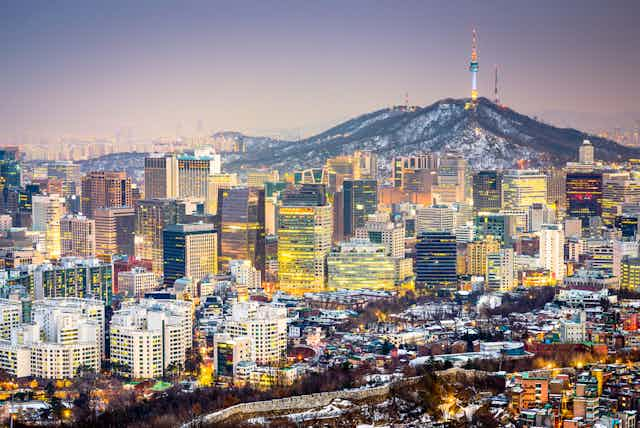South Korea, Taiwan, Malaysia and Indonesia all suffered from Japanese occupation during the second world war. But in the decades of peace that followed, South Korea and Taiwan revived, grew their economies and became rich. Their GDP per capita – what everyone in the country earns per year if income is equally distributed – are now on par with developed Western countries.
We are familiar with South Korean products, from cars and electronics to skincare. Taiwan exports refined oil, electronics and computers, such as Acer and Asus.
Malaysia, however, plateaued once it reached upper-middle income, a term the World Bank uses to define countries with a per capita GDP higher than US$1,045 but lower than US$12,736. In the meantime, Indonesia is still struggling in the lower-middle income level with GDP per capita below US$4,125.
Why do some countries grow faster than others?
Innovative local companies play a key role.
The tale of four economies
Around two decades after the second world war, in 1967, Malaysia led the four economies in GDP per capita at US$317. Taiwan’s was US$281, South Korea’s US$161 and Indonesia’s US$54.
Within two years, Taiwan overtook Malaysia. And a decade later, in 1977, it was Korea’s turn.
In 2003, Korea’s GDP per capita was US$14,209 – 90 times what it was in 1967. Taiwan’s GDP per capita was close, with US$14,120 in 2003.
Observers dubbed the growth of these four, along with Japan, Hong Kong, Thailand and Singapore in the 1980s and 1990s, as the Asian Miracle. Their GDP per capita grew twice as fast between 1965 and 1990 compared to more developed Western countries such as those Europe and North America.
The GDP per capita increase in these countries was accompanied by poverty reduction and a narrowing of the gap between the rich and poor.
The 1997 Asian Financial Crisis hit these economies hard. Korea saw its GDP per capita slump by 33.4%, Taiwan by 8.5%, Malaysia by 29.6% and Indonesia by 56.4%, bringing Indonesia back to low-income level.
But by 2017, the average income in Korea had again grown, to nearly US$30,000. Taiwan’s grew to US$24,000. Malaysia and Indonesia’s were behind with US$9,952 and US$3,847 respectively.
Why do some economies grow faster than others?
Economists use GDP per capita as an indicator of a country’s productivity rate – the output it has produced over a certain period. The higher the per capita GDP of an economy, the higher the productivity of its citizens. South Korea and Taiwan’s high GDP reflects their high productivity rate compared to Malaysia and Indonesia.
Three things determine a country’s productivity: labour, capital, and something known as total factor productivity (TFP), which represents efficiency and technology. For example, better management systems to reduce red tape could signal efficiency, while the use of technology to automate tasks that would take up a lot of time if done manually, technology.
According to the Asian Productivity Organisation, TFP contributed 14% to Korea’s economic growth between 1970 and 2016, and 24% for Taiwan. Meanwhile, TFP only contributed 5% to Malaysia’s growth, and for Indonesia, the percentage is even lower: 1%. This means there’s very little technological advancement in Indonesia.
The small contribution of TFP to Indonesia’s economy closely ties to the country’s low investment in research and development. In 2017, Indonesia spent less than 0.2% of its GDP on research and development. Meanwhile, Korea spent 4.55% of its GDP on research and development. Taiwan, in 2016 spent 3.16% and Malaysia around 1.3%
How to increase total factor productivity
A working paper for the International Monetary Fund showed that Korea and Taiwan’s economic growth has relied on technological innovation by local companies.
In the 1960s, South Korea founded 35 state-owned companies in the energy, construction and banking sectors. By the 1970s, to improve the public enterprises’ performance, South Korea began privatising state-owned companies, providing loans and protection from market competition to family-owned business groups – called chaebol in Korean.
Meanwhile, economist Chen Been-lon argues the government and private enterprises have been instrumental in helping Taiwan grow into today’s economic powerhouse.

In 1964, Taiwan built a semiconductor lab at the National Chiao Tung University. This lab was the training ground for many engineers who became the backbone of Taiwan’s semiconductor industry.
In 1974 a state-owned Electronic Research and Services Organization (ERSO) was established near National Chiao Tung University. In 1980 ERSO created its first spin-off company named United Microelectronics (UMC) with 40% capital investment coming from the government.
UMC moved on to become Taiwan’s centre for acquiring chip technologies, training local engineers and building the foundation of Taiwan semiconductor industries.
Support for domestic industries by the South Korean and Taiwanese government, through cheap loans and market protections, provided room for companies to increase the budget to develop technological innovation.
They also improved the quality of education, providing high-quality labour for companies that would need highly skilled workers.
In contrast to South Korea and Taiwan’s strategy, in which the government supported the development of domestic industries, the IMF paper noted Malaysia relied on transfer technology from multinational companies.
Multinational companies are reluctant to transfer their technologies to local companies, leaving host countries stuck supplying raw materials. Multinational companies protect their intellectual property rights and product development. They are also reluctant to train local hires lest they move to other companies.
This is the challenge Indonesia and Malaysia are facing. As domestic industries are underdeveloped in both countries, local companies have little to spare to fund research and development.
While South Korea and Taiwan have 15 and nine companies respectively listed in the Fortune 500 list, a ranking of the biggest companies in the world by revenue, both Indonesia and Malaysia each have only one company in the list, and they are the countries’ state oil and gas companies.
Catching up
Strong evidence, both from Korea and Taiwan, shows that to increase a country’s productivity, domestic industries must invest in research and development.
The Indonesian government is reportedly planning to introduce tax deductions for companies that support vocational training, research and development.
Along with incentives for companies, both Malaysia and Indonesia must improve their higher education sectors to support research and development – as well as increase investment in these areas. They must also develop reliable domestic companies.
Malaysia already allows foreign academics to teach and do research. Indonesia should follow this path as it needs to have world-class universities. The higher education sector should be given more autonomy to manage recruitment of lecturers and researchers, and to attract the best students from all over the world.
South Korea and Taiwan’s experience in supporting domestic industries and improving their research sector can be models for Malaysia and Indonesia.

The Indonesian Academy of Sciences supports The Conversation Indonesia as host partner.


